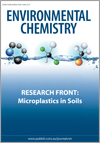
Environmental Chemistry
Volume 16 Number 1 2019
RESEARCH FRONT: Microplastics in Soils
Environmental context. Microplastic particles are increasingly recognised as human-caused pollutants in soil with potential harmful effects on soil microorganisms. Microplastics may also have evolutionary consequences for soil microbes, because the particles may alter conditions in the soil and hence selection pressures. Including an evolutionary perspective in an environmental assessment of microplastics could lead to new questions and novel insights into responses of soil microbes to this anthropogenic stressor.
Environmental context. Microplastics, long recognised as contaminants in aquatic ecosystems, are increasingly of environmental concern for terrestrial ecosystems. This study focuses on the potential of microplastics to act as carriers of agrochemicals and the subsequent effects on soil biota. The results indicate the need for further studies into how soil properties influence both the degradation of microplastics and their role as pollutant carriers.
EN18150Microplastics in soils: assessment, analytics and risks
Environmental context. There is increasing concern from both the general public and the scientific community about microplastic-related pollution. Despite the alarming and well-documented accumulation of plastics in the marine environment, little attention has been paid to the sources, fate and effects of microplastics in terrestrial settings. We overview the prevalence of microplastics in soils, evaluate their impacts, and appraise the current difficulties in their determinations in terms of sampling, isolation and identification.
EN18161Leaching of microplastics by preferential flow in earthworm (Lumbricus terrestris) burrows
 , Esperanza Huerta Lwanga, Xiaomei Yang, Shaoliang Zhang, Xiaoyi Ma, Coen J. Ritsema and Violette Geissen
, Esperanza Huerta Lwanga, Xiaomei Yang, Shaoliang Zhang, Xiaoyi Ma, Coen J. Ritsema and Violette Geissen
Environmental context. Microplastics found in soil pose several potential environmental risks. This study shows that microplastics on the soil surface can be ingested by earthworms and transported to the lower soil layers. In this way, microplastics may enter the food chain and find their way into groundwater systems, especially in cases where the water table is shallow.
Environmental context. Ranitidine, a widely prescribed antiulcer drug commonly found in surface waters, has been identified as an emerging contaminant due to its toxicity and the enhanced toxicity displayed by its transformation products. Mechanisms for the formation of ranitidine transformation products and their degradation pathways induced by UV oxidation processes are presented. This work provides insight into treatment processes to remove these toxic chemicals from environmental water bodies.
Environmental context. Metabolomics can be used to provide a snapshot of an organism’s physiology as the organism is exposed to varying environmental conditions. In this study, laboratory-reared amphibians were exposed to multiple pesticides, analogous to field exposures, resulting in an impact to both pesticide body concentrations and the amphibians’ hepatic metabolome. These data can be used in the environmental and ecological risk assessment of multiple pesticides in non-target species.
Environmental context. Water contamination by antibiotics and heavy metals entails potential risks to both the environment and human health. Composite materials based on MgAl-layered double hydroxides and biochar simultaneously adsorbed the toxic sulfamethoxazole and CrVI metal species. These findings indicate that biochar/metal hydroxide composites could be valuable adsorbents for the simultaneous removal of trace antibiotics and metals from water.



